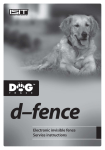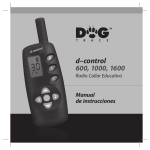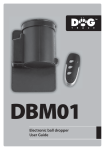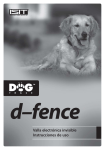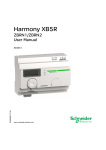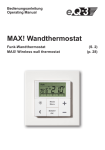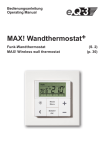Download Dog trace d-fence Technical data
Transcript
Service instructions d–control 400 Electronic training collar – basic training set for a single dog d–control 401 Electronic training collar – basic training set for a single dog – briefcase version d–control 402 Electronic training collar – basic training set for two dogs – briefcase version Thank you for purchasing the product DOGtrace™ d–control from VNT electronics s.r.o., Czech Republic. We would like to ask you for reading this manual carefully before using the unit and keeping it for future use. EC Declaration of Conformity Guideline R&TTE 1999/5/CE The manufacturer: VNT electronics s.r.o. declares that the below mentioned product: Electronic training collar DOGtrace™ d–control complies to all Europe Council Guidelines, Under No. 1999/5/CE of 7. 4. 1999 and corresponds to the following standards: ETSI EN 300 220 CE VNT electronics s.r.o. • Němčice 23 • 561 18 Němčice u České Třebové Phone: +420 461 310 762 • Czech Republic • www.dogtrace.com WARNING: The person with a personal instrument to support heart activity (pacemaker, defibrillator) must respect the relevant precautionary measures. The d–control emits a certain stationary magnetic field (lower part of the remote controller and RF signals). Frequency= 869.52 MHz, maximum transmitted power = 25 mW. 2 Contents Introduction . . . . . . . . . . . . . . . . . . . . . . . . . . . . . . . . . . . . . . . . . . . . . . . . . . . . . . . . . . . . . . . . . . . . . . . . . . . . . . . . 4 Scope of delivery . . . . . . . . . . . . . . . . . . . . . . . . . . . . . . . . . . . . . . . . . . . . . . . . . . . . . . . . . . . . . . . . . . . . . . . . . . . 4 Optional accessories . . . . . . . . . . . . . . . . . . . . . . . . . . . . . . . . . . . . . . . . . . . . . . . . . . . . . . . . . . . . . . . . . . . . . . . . 4 Product description . . . . . . . . . . . . . . . . . . . . . . . . . . . . . . . . . . . . . . . . . . . . . . . . . . . . . . . . . . . . . . . . . . . . . . . . . 5 Battery installation and replacement . . . . . . . . . . . . . . . . . . . . . . . . . . . . . . . . . . . . . . . . . . . . . . . . . . . . . . . . 6 Turning ON/OFF . . . . . . . . . . . . . . . . . . . . . . . . . . . . . . . . . . . . . . . . . . . . . . . . . . . . . . . . . . . . . . . . . . . . . . . . . . . . 8 Programming (matching) of the remote controller and the receiver . . . . . . . . . . . . . . . . . . . . . . . . . 9 How to use the remote controller . . . . . . . . . . . . . . . . . . . . . . . . . . . . . . . . . . . . . . . . . . . . . . . . . . . . . . . . . . 10 How to check that your DOGtrace™ d–control works correctly . . . . . . . . . . . . . . . . . . . . . . . . . . . . . . 12 For the best results . . . . . . . . . . . . . . . . . . . . . . . . . . . . . . . . . . . . . . . . . . . . . . . . . . . . . . . . . . . . . . . . . . . . . . . . 13 We are starting with the training collar . . . . . . . . . . . . . . . . . . . . . . . . . . . . . . . . . . . . . . . . . . . . . . . . . . . . . 14 Tips . . . . . . . . . . . . . . . . . . . . . . . . . . . . . . . . . . . . . . . . . . . . . . . . . . . . . . . . . . . . . . . . . . . . . . . . . . . . . . . . . . . . . . . 16 Hints for using . . . . . . . . . . . . . . . . . . . . . . . . . . . . . . . . . . . . . . . . . . . . . . . . . . . . . . . . . . . . . . . . . . . . . . . . . . . . . 17 Maintenance . . . . . . . . . . . . . . . . . . . . . . . . . . . . . . . . . . . . . . . . . . . . . . . . . . . . . . . . . . . . . . . . . . . . . . . . . . . . . . 17 Troubleshooting . . . . . . . . . . . . . . . . . . . . . . . . . . . . . . . . . . . . . . . . . . . . . . . . . . . . . . . . . . . . . . . . . . . . . . . . . . . 18 Warranty . . . . . . . . . . . . . . . . . . . . . . . . . . . . . . . . . . . . . . . . . . . . . . . . . . . . . . . . . . . . . . . . . . . . . . . . . . . . . . . . . . 19 Technical data . . . . . . . . . . . . . . . . . . . . . . . . . . . . . . . . . . . . . . . . . . . . . . . . . . . . . . . . . . . . . . . . . . . . . . . . . . . . . 20 3 Introduction Do you need to have your dog under instant control? Do you want to train and breed it easily, quickly, precisely, and efficiently? Electronic training system DOGtrace™ d–control, consisting of the transmitter and the collar, will help you train your dog with efficiency unattainable with other methods. The hand-held transmitter (similar to the remote controller controlling your TV set) makes it possible to give orders to a large distance. There are two sorts of order. A warning sound signal, a short alerting electronic pulse, and a series of correcting electronic pulses. It is possible to adjust the intensity of electronic pulses in a simple way. Electronic systems of the transmitter and collar use state-of-the-art technology based on single-chip microprocessors and wireless communications. Thanks to the ergonomic design and low weight of the collar, it is possible to use it also for small breeds of dog. Scope of delivery } } } } } } } } Collar (receiver) with the strap (2pc in d–control 402) Electrodes CR2 3V lithium battery 2pc (3pc in d–control 402) Neon test discharge lamp Remote controller (transmitter) with the fastener Cord to hang the transmitter on the neck Service instructions and Certificate of Warranty Briefcase (with d–control 401 and d–control 402) Optional accessories } Dummy collars } Varicoloured woven belts } Spare electrodes 4 } Spare batteries } Spare seals } Spare screws Product description REMOTE CONTROLLER COLLAR WITH THE STRAP 2 1 3 2 1 4 3 4 5 6 7 7 1 2 LCD PANEL DESCRIPTION 6 3 4 REMOTE CONTROLLER } 1 – Backlit LCD display, 2 – Adjustable permanent pulse (booster) button, 3 – Correction pulse button, 4 – Sound signal button, 5 – Power ON/OFF button, 6 – Buttons to select a level of correction pulses, 7 – Dog A or Dog B Selector. COLLAR WITH THE STRAP } 1 – Strap, 2 – Electrodes, 3 – Indicator, 4 – Target. LCD PANEL DESCRIPTION } 1 – Transmission indication, 2 – Battery power indicator, 3 – Indicator of preset level of correction pulses, 4 – Dog A or Dog B selection indicator. 5 Battery installation and replacement INSTALLATION (REPLACEMENT) OF THE BATTERY IN THE RECEIVER (COLLAR) } Remove 4 screws of the receiver housing cover plate with a cross-head screwdriver. Install the 3V lithium CR2 battery. Mind the correct polarity indicated on the receiver PCB with “+“ symbol in the battery compartment (see the photo). } A beep indicating correct installation of battery will sound. } If you do not hear the beep after installation of the battery, remove it immediately. Check the polarity and try to install it again. } Before putting the plate cover to its place make sure that the rubber seal is correctly seated in its slot. Tighten adequately the 4 screws on the cover plate of the receiver. Checking the battery power Look at the indicator on the front panel of the receiver (collar) to check the state of battery: } The battery is fully charged: The LED indicator in on-state blinks slowly in green. } The battery is weak: The LED indicator in on-state blinks in red. Prepare a spare 3V lithium battery CR2 and follow the section describing the battery installation. Make sure that the receiver works correctly. Battery polarity indication 6 INSTALLATION (REPLACEMENT) OF THE BATTERY IN THE REMOTE CONTROLLER } Unscrew the screw on the rest side of the repote controller and lift off carefully the cover of the controller. Watch out, it is connected with the keypad by a wire. Install a new button cell (3V lithiová typ CR 2450) and mind the correct polarity (see the photo). The “+“ symbol on the cell must be up after installation, i.e. visible. Replace the cover of the box and tighten the screw adequately. Checking the battery power To check the state of the transmitter battery, look at the LCD display: } The battery is fully charged: The symbol of battery is permanently lit on the LCD display in on-state. } The battery is weak: The symbol of battery starts blinking on the LCD display in on-state. Prepare a spare 3V lithium battery CR2450 and follow the previous section “Installation of the battery in the remote controller”. Make sure that the remote controller works correctly. TIP You can remove the batteries more easily if you use a small screwdriver and insert it carefully under the edge of the battery (from the opposite side than the LCD). Battery compartment 7 Turning ON/OFF TURNING THE REMOTE CONTROLLER ON/OFF } Turning on: Press down for 1 second the black On/Off button on the remote controller. Turning on is indicated by lighting up of the LCD display. } Switching off : Again, press down for 1 second the black On/Off button. Turning off is indicated by going out of the LCD display. } CAUTION: To save the service life of the battery, the transmitter will be automatically turned off after 120 minutes of inactivity. TURNING THE RECEIVER (COLLAR) ON/OFF The magnetic switching system located in the remote controller is used to turn the receiver (collar) on and off. } Turning on: Touch the lower part of the remote controller for 1 second to the target on the receiver (refer to the Fig.). The receiver indicator will start blinking in green and this indicates that the receiver is ready for use. } Turning off : Again, touch the lower part of the remote controller for 1 second to the target on the receiver (see the Fig.). The LED indicator of the receiver will be lit red. The receiver is turned off. To extend the serviceability of the battery, it is necessary to turn off the receiver always after training is finished. If you do not use the receiver for a longer period of time, we recommend you to remove the battery from the receiver. 8 The situation when the receiver is turned on/off and the transmitter is being matched with the receiver Programming (matching) of the remote controller and the receiver Every remote controller has its own RF operational code. Programming of the remote controller with the receiver (collar) will be accomplished during the first use of the DOGtrace™ d–control or with a new remote controller or a receiver (when one or the other is lost). This operation will enable you to match your remote controller with the delivered receiver (collar). } IMPORTANT: Before programming is started (before the first use of your receiver or code rewriting) make sure that no one else uses his/her d–control or another product made by DOGtrace™ in your neighbourhood – your receiver could randomly receive the code from the other remote controller and set itself to it. If this happens, program your receiver once again using your remote controller. } Turn on your transmitter. } Select Dog A using the button on the transmitter } Touch the lower part of your remote controller to the target on your receiver (see the photo on page 7). The green LED will be permanently lit and after some 6 seconds, it will switch to the programming mode, indicated by permanent flashing of the red LED. } Now take your transmitter away and press down the sound signal button on your remote controller. The codes will be matched in this step and your receiver will produce a sound signal. } Select Dog B using the button on the transmitter and proceed in the same way (it is applicable when you wish to use your d–control for the other dog by purchasing another receiver or if you have purchased the d–control 402). 9 NEW PROGRAMMING OF YOUR RECEIVER The receiver can be programmed repeatedly without restraint either using the same remote controller or with another (see the section Programming (matching) of your remote controller and receiver). TIP It is possible to program an unlimited number of receivers to one receiver, which is possible to use for common training of several dogs. It is possible to record two transmitters into one receiver, which the instructor can use, for instance, for a potential correction of the dog’s training. How to use the remote controller The DOGtrace™ d–control remoter controller is designed for co-operation with two separate receivers independent of each other (A Dog or B Dog selection). Button – sound signal When you press down the sound signal button, you will be able to send the sound signal to your receiver at a great distance. There is no time limit for this function: The buzzer will sound for as long as you are holding the pressed down button and the green LED on your receiver will be permanently lit. It will be indicated by the transmission symbol on the LCD display of your remote controller. – permanent pulse Button By pressing down this button, you will send your dog a warning in the form of an electronic pulse transmitted by the two electrodes located in the receiving collar for a defined period of time, which is shorter than one second (regardless of how long you are pressing down the button). It is necessary to hold the button pressed for one second at least. The red LED on your receiver will glimpse. It will be indicated by the transmission symbol on the LCD display of your remote controller. 10 Button – adjustable permanent pulse (booster) Use this button to select a higher intensity of the correction pulse by 0–5 levels than the one selected by the permanent pulse button. Example: } + levels 0–5 = PROCEDURE: Keep pressing down the button for selection of A-dog or B-dog (depending on the assignment of your receiver in which you want to use the above mentioned setting) until symbol A or B starts flashing on the LCD. Use the buttons for selection of correction pulse level and set a number by how many levels this button should be higher. Confirm your selection by pressing down the same button again. Control buttons These buttons are used for quick selection of intensity of pulses from the receiving collar. It is possible to set 20 levels, indicated by numbers 0–19 on the LCD display. When the preset correction pulse level is changed, the LCD will be lit for 3 seconds. Level 0: weakest pulse. Level 19: strongest pulse. Control buttons The purpose of these buttons is to select A-dog or B-dog. You can set a different level of the correction pulse for each dog, which will be kept even after the other dog is selected. 11 How to check that your DOGtrace™ d–control works correctly You can check anytime whether your set works correctly. Before the check, make sure that the receiving collar is turned off. } Connect the leads of the testing discharge lamp to both electrodes (loosen up the electrodes, insert the wires of the lamp under them so that they can be firmly held and then retighten the electrodes). } Turn on your remote controller and receiver. } Press down the button for sending a correction pulse. The testing discharge lamp will indicate the receipt of the signal by a blink. The alteration of the intensity of the pulses according to options 1 to 9 will be indicated by a weaker or stronger light of the lamp. } At this moment, the correction pulse is only indicated by the light of the lamp, i.e. the electrodes do not emit any correction pulses. Location of the test lamp attachment 12 For the best results Training orders, you are sending to your dog, are transmitted from the transmitting unit to the collar equipped with the receiver by radio waves. The propagation of radio waves is influenced by a series of factors and under normal conditions the range of this unit is approximately 200 meters (depending on geographic conditions and surroundings). If you want to get the best results with your unit, adhere to the following instructions: } To reach the best range for your communication, hold your remote controller in your hand and do not cover its front part (the antenna is located there). } If you hold your remote controller in front of you with your hand reached out, the range will get longer. } Before using your training set, always check the batteries in the remote controller and in the collar and replace them if necessary. } The power of batteries slightly falls down at temperatures below 0 °C. If it is possible, keep your remote controller warm (e.g. in your pocket) and take it out only for use. SELECTION OF ELECTRODES Every package contains readily two kinds of electrodes. If your dog is small and its fur is short, use short electrodes. If your dog is of medium built or big, use long electrodes. ATTACHMENT OF THE COLLAR The strap of the collar must be adjusted so that the electrodes can be in contact with the dog’s skin. When the strap is too slack, the dollar is likely to move and repeated fiction may irritate your dog’s skin. Moreover, in this case the contact with the skin surface is not reliable and the same holds true for proper operation of the collar. We do not recommend you to leave your dog wearing the collar for several hours in the same place as it might cause skin irritation. If it is necessary for your dog to wear the collar for a long time, TIP If you attach the receiver on your dog’s neck laterally, you change its position on your will extend the range of transmission. dog’s neck. 13 We are starting with the training collar } The trainer’s elementary knowledge in training dogs is the prerequisite for using the training collar. } If you do not have this knowledge, we recommend you to turn to a training centre, a cynology club, or a school for dogs where you will learn the basic communication with your dog. } You can start using the collar for a 6-month-old puppy who has undergone the basic training ”SIT“, ”DOWN“, “STAY“, or at least ”FIE“, “YOU MUSTN’T“… } Demand these commands along with the sound signal from the collar so that your dog can create a link between them. } After a command is successfully executed, you should always reward or encourage your dog so that it can execute your commands with delight and its desire to make you happy could grow. } You must not consider the executed command as the absolute obviousness and punish only disobedience – your dog would soon fall away from you. } If you are not sure that your dog will obey you after recalling, start training, e.g. using a tracing dog-lead. } Your dog will have to get used to the collar; let the dog wear the collar for a few days, but do not use it so that your pet does not discover the connection with its attachment and effects. } Affirmative and efficient training requires some time: do not hurry! } Select a well-known environment your dog is used to. } Select the right moment for pressing the button; exactly at the moment when your dog is doing something forbidden. } Do not hesitate to contact a professional trainer for more advice and in the event of any problems. } We do not recommend you to use the collar for the dogs not being in good physical health state (e.g. heart problems, epilepsy, etc.) or having behaviour disorders. 14 Sound signal It is only up to you how you will use it, which depends on the method you wish to train your dog. With the sound signal you can: } Send a sound warning to your dog when it is doing something inappropriate. } Catch the attention of your dog… } Teach it that this signal means the command ”To me“, ”Stay“, wherever the dog is (the sound signal replaces your dog-whistle). The sound signal forgoing the pulse is very efficient; Your dog will soon create a link between its incorrect behaviour, the sound warning, and its unpleasant feeling. It is very important to always use the sound signal in the same way to avoid your dog of being confused. Button – permanent pulse & button – Adjustable permanent pulse (booster) If your dog does not obey your command and the following sound signal, send it a correction pulse (at a suitable level) to get it out of its activity and draw its attention to you. The objective of this correction pulse is not to hurt your dog, but the pulse is very unpleasant for it and the result is that your dog will soon realize the connectedness between your command, the sound, and its unpleasant feeling. Only a minimum of these correction pulses will be necessary in the course of time since your dog will put it together very well with its disobedience of your command and later, it will be enough to give a command, eventually accompanied with a sound signal. Thanks to this button, you can send to your dog‘s collar a long pulse (press down the button and hold it longer) or a short pulse (press down the button for a very short time – however, for 1 second at least). } It is the first step of the training } Training should be performed on the place your dog knows very well (at the beginning) } As the pulse is longer, use a lower intensity and use the length of the pulse rather than its intensity so that your dog can have time to understand what is going on } Short pulses are used in later stages of the training when your dog has already been trained with long pulses } The pulses used here are higher than those used in training with permanent pulses 15 Adjustable permanent pulse (booster) button By using this button, you can set the intensity of the correction pulse by o 0–5 levels higher than the one you have selected with the permanent pulse button; use this button to solve extreme situations when your dog did not respond to the standard level of correction pulse you set. However, use these correction pulses in extraordinary cases only. Tips With the DOGtrace™ collars it is extremely easy and quick to teach the dog: } To walk along without a dog-lead. } To call in reliably (”To me“, ”Come to me“ commands). } To interrupt an inappropriate activity (”Fie“, ”You mustn’t“). } To unteach bad habits during daily coexistence with people, such as taking food from the table, jumping at people, pawing, undesirable barking, etc. } Precise training of virtually every skill whereas the dog must do it precisely and reliably as if it were on a lead (as many as hundreds of meters long!) – with the removal of the undesirable dependence on the lead which the dog knows very well and adapts its behaviour to it. } To unteach chasing animals and running away from its master in the country – and thus being exposed to problems and risks related to them, so the solution bringing more freedom for your dog who now can move freely also across patches where it would not otherwise be possible or it would be dangerous. } Special activities and commands for business, hunting, sports or other training. } Using directly during hunting for communication with the dog. } A series of other activities and applications which the owner of this unit will soon discover in daily common life with his/her dog. 16 Hints for using } Do not place your remote controller close to objects sensitive to magnetic fields that might get damaged and be out of repair. } Do not put your d–control in places exposed to high temperatures. } It is necessary to replace the batteries every two years and also in the case that the set is not used for a long time. Never leave a flat battery in your unit; it might leak and damage your unit. } Repeated contacts of the electrodes with the dog’s skin may cause its irritation. If this happens, do not use the collar until all traces of irritation are gone. } WARNING!!! In the event that your dog has a wet fur, use a lower level of the correction pulse than you usually use. Maintenance Never use volatile agents such as thinners, petrol, or various cleaners to clean your DOGtrace™ d–control. Use a soft damped cloth and a neutral clearing agent if necessary. The receiver (collar) DOGtrace™ d–control is water-tight only on condition of a good state of the seal and after its treatment with silicone vaseline. If this is fulfilled, your dog can even swim with that. In order to maintain the water-tightness of your receiver, we recommend to replace the rubber seal under the receiver’s cover and treat it with silicone vaseline. After every replacement of the battery in the collar, make sure that the seal is properly cleaned and settled and that the screws are adequately tightened. Check them regularly and tighten them only adequately! 17 The remote controller is only waterproof against spraying water not against submersion. Its design allows to withstand a short time in the rain. Protect it against water and moisture however it is possible. If it is dropped into water, it will certainly be irrecoverably damaged or destroyed. If you do not use the unit for a long time, remove the batteries from your remote controller and receiver. The collar will remember the preset configuration (autoencoding). When you turn it on next time, it will be in the mode you selected last time. Troubleshooting Before you start considering your unit to be faulty: } Read out this Service Instruction manual once again and make sure that the problem is not caused by weak batteries or by incorrect application. } Check to see if the batteries are positioned correctly with regard to their polarity. } If a problem persists, try to initialize the system by removing the battery from the battery holders in the receiver, then use a metal tool (e.g. a screwdriver, scissors, etc.) and short-circuit both contacts – battery holders for about 2 seconds. Reinstall the battery. The unit emits a beep confirming that the battery is installed with correct polarity. } Unless this helps, program your receiver again. Clear the previous code in the memory and then match your receiver with the remote controller according to instructions in this manual. If the problem persists, contact your supplier. 18 Warranty DOGtrace™ provides the product with warranty for possible manufacture faults to the extent of two years from the date of purchase. The manufacturer does not take responsibility for damage to the instrument caused by incorrect use, unauthorized repairs and dismantling. The warranty does not cover the following items: } Batteries } New straps } Direct or indirect risks during transportation of the product to the seller } Damage to the product caused by user’s negligence or by an accident (e.g. by masticating, breaking, impacts, etc.) and by interventions of unauthorized persons. The information contained in this manual may be subject to alterations without prior notice. 19 Technical data TRANSMITTER } Weight . . . . . . . . . . . . . . . . . . . . . . . . . . . . . . . . . . . . . . . . . . . . 64 grams (without battery) } Range . . . . . . . . . . . . . . . . . . . . . . . . . . . . . . . . . . . . . . . . . . . . . approx. 200 meters in the free area } } } } } } } } } Power supply . . . . . . . . . . . . . . . . . . . . . . . . . . . . . . . . . . . . . . Battery serviceability . . . . . . . . . . . . . . . . . . . . . . . . . . . . . . . Frequency (output) . . . . . . . . . . . . . . . . . . . . . . . . . . . . . . . . Antenna . . . . . . . . . . . . . . . . . . . . . . . . . . . . . . . . . . . . . . . . . . . IP code . . . . . . . . . . . . . . . . . . . . . . . . . . . . . . . . . . . . . . . . . . . . Radio communication safety and coding . . . . . . . . . . . Number of pulse levels. . . . . . . . . . . . . . . . . . . . . . . . . . . . . Operating temperature . . . . . . . . . . . . . . . . . . . . . . . . . . . . Dimensions . . . . . . . . . . . . . . . . . . . . . . . . . . . . . . . . . . . . . . . . 3V CR2450 lithium battery cell 6–12 months, based on usage 869.525 MHz (25 mW) Integrated Protected against spraying water By microcontroller 20 –10 °C to + 50 °C 110 × 52 × 30 mm RECEIVER (COLLAR) } } } } } } } } } Weight . . . . . . . . . . . . . . . . . . . . . . . . . . . . . . . . . . . . . . . . . . . . Power supply . . . . . . . . . . . . . . . . . . . . . . . . . . . . . . . . . . . . . . Battery serviceability . . . . . . . . . . . . . . . . . . . . . . . . . . . . . . . Frequency . . . . . . . . . . . . . . . . . . . . . . . . . . . . . . . . . . . . . . . . . Antenna . . . . . . . . . . . . . . . . . . . . . . . . . . . . . . . . . . . . . . . . . . . IP code . . . . . . . . . . . . . . . . . . . . . . . . . . . . . . . . . . . . . . . . . . . . Radio communication safety and coding . . . . . . . . . . . Operating temperature . . . . . . . . . . . . . . . . . . . . . . . . . . . . Adjustable neck circumference . . . . . . . . . . . . . . . . . . . . . } Dimensions . . . . . . . . . . . . . . . . . . . . . . . . . . . . . . . . . . . . . . . . 20 56 grams (without the strap and the battery) CR2 3V lithium battery 6 months, based on usage 869.525 MHz Integrated Against submersion By microcontroller –10 °C to + 50 °C 20 to 75 centimetres 62 × 42 × 30 mm Electronic invisible fence Do you have a wandering pet not paying attention to your protests who likes traveling nearby and far from your house? Or is it a garden lover who likes your garden patches or a swimmer who loves swimming in your pool? Twisted leads Transmitter Warning zone Correction zone The d–fence is a modern and highly efficient system enabling one or more dogs to run freely in the area, fenced or fenceless, which you will provide it.





















